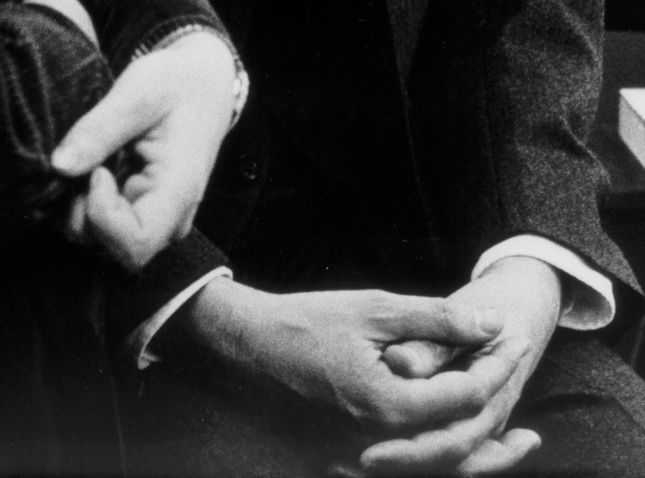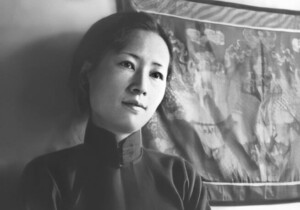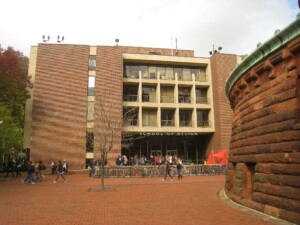Below is a transcription of Denise Scott Brown‘s comments at the June 15 memorial service for the late Robert Venturi at the University of Pennsylvania‘s Fisher Fine Arts Library. The following transcript has been lightly edited for clarity.
It’s lovely to see you all. There are some recent friends and also people I hadn’t seen since 1960. One came up, a planner: I once said to him, “That’s not suitable for high school, it’s not even suitable for elementary school,” and I wondered what he became. He said, “well I have been the ambassador to Burundi.” That makes me so happy. He was wonderful then and obviously is now.
Bill, who lived in our basement, has talked about Bob in the studio. We’d hear him say, “This is a terrible idea… but wait, let’s see.” He would rather take it up than say, “oh no, we couldn’t do that.” But he might say, “I haven’t understood the system of the building yet.” Few people knew he thought that way or knew his strong ability to go from analysis to synthesis over and again—to be extremely rigorous. But I respected him for it.
I’m happy we are holding this memorial here, because the Furness library has been such an important place for us. Bob and I met here. But he had, in fact, saw Robert Scott Brown and me at a presentation our planning studio made to Lou Kahn in 1959. He was very impressed by Robert, who had stayed up one night until 3 a.m. with Bill Alonso who had taught him rent theory, so Robert could explain how roads influence the design of buildings and cities. I had merely noted that Lou Kahn had with him a young assistant. And then within two weeks Robert was killed. I went back home and returned to Penn in the fall a sad, young widow. But I graduated and started teaching in 1960, and within the first week or so there was a faculty meeting.
At the AA you as a student could enter anyone’s jury. I had done this at Penn, and that was another reason Bob knew me slightly. And at the faculty meeting I did it again. “Why are you taking this building down?” I asked. I had seen in London the Horniman Museum and Whitechapel Gallery of the architect Townsend, and the Furness Library, especially its scale jumps, reminded me of them. I was very interested in scale jumps, and the Mannerism they were part of. Seen as aberrant, Mannerism was reappraised in England in the 1940s. Nicholas Pevsner, its rediscoverer, and one of his students, here tonight, and also John Summerson, guided me through Mannerism. I listened two years running to Summerson’s AA lectures on Classicism, travelled in England, France and Italy, with Pevsner’s book and Robin Middleton’s itinerary, and learned a great deal.
Bob grew up in Philadelphia. He was a moony little child. His parents took him out of Quaker school when they found his desk in the corridor outside the classroom. He was apparently talking too much. An old teacher friend of his mother said, “send him to a structured and disciplined place,” That was Episcopal Academy. “I went there,” Bob said, “and went underground.” The school was suitable—structured, disciplined, but very kind. And we love Jim Squires, our client for its chapel. But there were only two little Italian boys in the school, and in history class, the teacher said, “immigrants from the North were preferable to those from the South.”
Bob and I shared that. I had to put up with anti-Semitism at my prep school in South Africa. But I believe that being different—having skewed views—is useful to creative people. Our wayward eyes quickly joined forces, we shared mannerism and being marginal. This made for a very interesting five years that few knew we had shared.

The going story is that Bob went to Rome, discovered Mannerism in the library, came back, and started to do it. Yes, he learned about it in Rome, but 12 days before he left. And can you imagine Bob sitting in the library when the whole of Rome is outside to explore? I’ve seen him in Rome, visited churches with him many times. And all those, they were baroque churches. He went where Giedion sent him. He saw a jillion little towns—hill towns—all over. And he got to Egypt with friends. When was the time to do all that reading?
But about twelve days before he left, Jim and Sally Gresham took Bob and Chuck Brickbauer to see the work of Armando Brasini on the outskirts of Rome. He was a fascist, still living in his remarkable palazzo, and Bob visited him. Back in America, he [Bob] had lots to do. His Dad was very ill. He had to run the fruit and produce business, which we later ran together. It was three blocks from the architecture office. Long-haired, egg-head fruit merchant—that’s part of him—Princeton gentleman with a southern Italian opera background. It was these mixtures that we started with. And Dave Crane said, “Denise you should marry Bob Venturi, and I’ll invite you both to dinner.” By the time he did, we had already had dinner.
We started by going to his office and seeing his designs, then he took me to a Princeton ball game. Bob went to a “ball game” by going to the library while the ball game was played, and when it was over, his friends wouldn’t tell him who had won. But in the library, I found Lutyens’ four volumes on his houses. I had had two years of lectures on Mannerism with Summerson, and had traveled to Venice using Robin Middleton’s list of buildings and paintings to see on the way to Venice and then on to Rome. And, though we had a lot to share, Bob had not seen those books. I said, “You mean you’re interested in Lutyens and you haven’t seen these?” Well, he went and bought them and within two weeks he knew them better than I did. He was thrilled with what I had learned, and I was equally thrilled with what he learned from two years of lecture with Donald Drew Egbert at Princeton.
At Penn, we taught consecutive semesters of a theories course, surveying architecture, landscape architecture, and planning. Mine was an overview of them all with selected faculty from each department, introducing their field and their interests. I gave one lecture, but my role was to pull it all together. Although I was a faculty member, Holmes treated me as a TA. I had to give out photographs on boards for students to draw from, because learning to draw was part of this course, as well as learning some modern architectural classics. Soon I was getting killed by my class. “Don’t you see that we’re graduate students!” So I broke the rules and defined my job as linking theory and practice via drawing as Holmes had wanted, but having them choose their examples and analyzing them via the subject matter of the lecture to lead toward studio design problems. We shared them with each other and with Bob.
He was running the Spring semester course on theories of architecture. As Holmes said, “You went to Princeton, you know history.” But the underlying message was, you didn’t go to Harvard so you won’t be staying here long, and it applied to both of us.
Meanwhile, teaching together, putting our two courses together, was all sorts of fun. And that’s what Bob was mainly doing. The archive here at Penn is full of his notes. Now he sat in this library all the time, working 80 hours a week finding slides and reading on the very wide topics he used to augment the Vitruvian components of architecture from three to fifteen and giving a lecture on one each week, surveying how different eras of architecture, for example, how light was let into buildings.
Robert Scott Brown and I had done a great deal of photography while traveling. We spent a month photographing in Venice, seeing what we were doing as making a record to take home to South Africa. But it grew on route to showing ideas through photography. At Penn, I used mine for teaching. Then I said, “Hey Bob, I’ve got slides that you can use for your lecture on scale.” We began sharing photographs and helpful book references. Then Bob, having seen the connections I was making between theory and studio for my course, asked me to devise equivalent work topics for his. Eventually, I did so formally by running the tutorials for both courses during the last semester, we collaborated at Penn.
I ran the tutorials, the drawing and research exercises, and the link to studio. And the next place you’ll find that type of work is in the programs for the Learning from Las Vegas studio. Later I learned that when we left Penn, the performance in studio went way down, because research-design connections were no longer made.
So that’s the story from one side. On the other were the planners. They were like Rabbinical students jumping up on the tables and arguing, and I argued with them. I also argued with Paul Davidoff, without leaving my seat. We occupied two small rooms across a corridor from each other in a basement studio. We merely leaned over to argue from our seats and across the corridor and groups of students would form around the doors to listen. Then we might go upstairs to the coffee machine and a larger group might form. As far as I could see, that was the only time planners and architects willingly came together.
But the strength of the planning school was a wonderful strength for me and the basis for connections between Las Vegas and architecture that Bob and I later made, and things like that. Bob was fascinated by the social planners. His mother was a socialist and a pacifist, so he could hear Paul Davidoff when he said, “Why do you have to go as far as Ville Radieuse, the city isn’t that bad. It’s pretty good. It’s almost all right.” And that’s where Bob got, “Is not main street almost all right?” that comes from Paul.
Bob was very open to what was going on in my West Philadelphia studio and the planning school in general. But no one else in architecture was interested at that time. So when I went to Las Vegas, Bob was the only colleague I invited to come with me. And when planning his theories course, delved with my help into urban and planning thought. And I could help with early Modernism. His research files in the archive, contain a note saying “Function and beauty, Denise.” He is not saying I epitomize both. He says, “remember what she had to say about how the early Modern functionalists saw that relationship,” and he included my information in his lecture on function. I’m more than pleased to explain to you what Bob meant and also how I saw my role of linking architecture and planning, as that of a circus horse rider as the horses spread apart. But sadly Nixonism and Reganism separated architecture and planning until connection was almost impossible to make. It still is.
Other things happened, so it didn’t work that way, but architects took strongly to these ideas as published in Learning from Las Vegas and turned them creatively to their own talents to something that designers could use and love. I have wanted to show you that our first five years of collaboration were an amazingly happy time. That’s what I was so happy about. And I’m happy about the rest, though our careers were a long, slow, gently sloping motion. And Bob, for much of his career, felt like Milton in his sonnet, “On His Blindness,” where, “that one talent which is death to hide, / Lodg’d with me useless.” Bob was a frustrated young architect because he could design so much more than he was hired to do. But slowly we built up, and eventually one day, after arguing with ourselves, we realized we really had achieved what we wanted to achieve. And sure, thirty of our projects could fit into one of I.M. Pei’s, but I feel I.M., an architect I much respect, would have liked to be the architect of the National Gallery. Just before he died, Bob said to me, “I’m a very, very old man.” And he was. And he thought he would die at the age his father had died, 69. And he was happy indeed at all that had happened despite our problems.
You’ve told us how wonderful it’s been having us in your lives. And I’m telling you how terribly important you are to ours.











